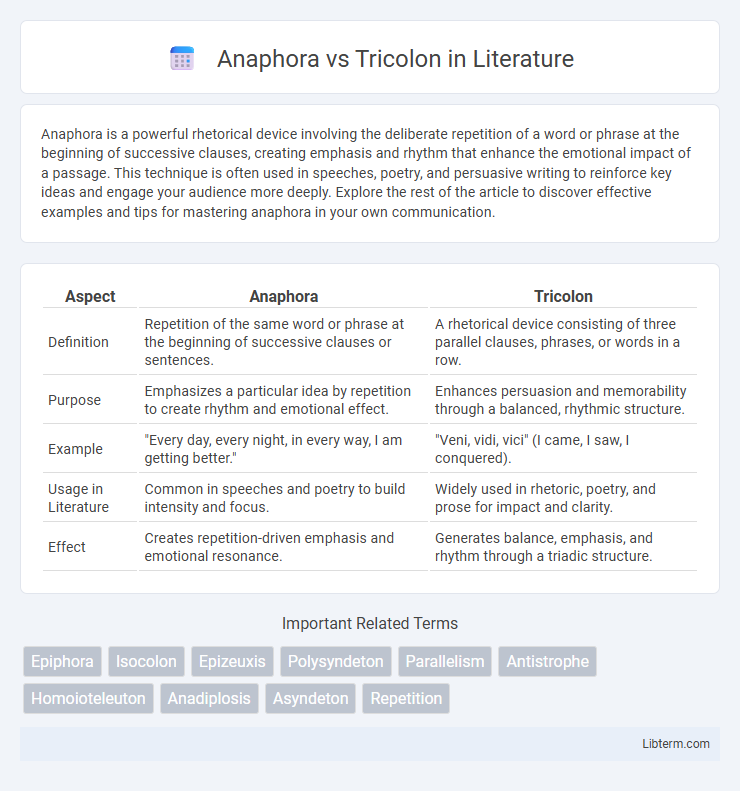Anaphora is a powerful rhetorical device involving the deliberate repetition of a word or phrase at the beginning of successive clauses, creating emphasis and rhythm that enhance the emotional impact of a passage. This technique is often used in speeches, poetry, and persuasive writing to reinforce key ideas and engage your audience more deeply. Explore the rest of the article to discover effective examples and tips for mastering anaphora in your own communication.
Table of Comparison
| Aspect | Anaphora | Tricolon |
|---|---|---|
| Definition | Repetition of the same word or phrase at the beginning of successive clauses or sentences. | A rhetorical device consisting of three parallel clauses, phrases, or words in a row. |
| Purpose | Emphasizes a particular idea by repetition to create rhythm and emotional effect. | Enhances persuasion and memorability through a balanced, rhythmic structure. |
| Example | "Every day, every night, in every way, I am getting better." | "Veni, vidi, vici" (I came, I saw, I conquered). |
| Usage in Literature | Common in speeches and poetry to build intensity and focus. | Widely used in rhetoric, poetry, and prose for impact and clarity. |
| Effect | Creates repetition-driven emphasis and emotional resonance. | Generates balance, emphasis, and rhythm through a triadic structure. |
Introduction to Anaphora and Tricolon
Anaphora is a rhetorical device involving the repetition of a word or phrase at the beginning of successive clauses to create emphasis and rhythm. Tricolon, a stylistic technique, consists of three parallel elements, phrases, or clauses that provide balance and completeness to a sentence. Both devices enhance persuasive and poetic language by reinforcing key ideas through structured repetition and patterning.
Defining Anaphora: A Stylistic Overview
Anaphora is a rhetorical device characterized by the deliberate repetition of a word or phrase at the beginning of successive clauses or sentences, enhancing emphasis and emotional impact. Unlike tricolon, which organizes ideas into a series of three parallel elements for memorable rhythm and structure, anaphora specifically leverages repetition to create coherence and reinforce a particular message. This stylistic technique is widely used in literature, speeches, and persuasive writing to engage audiences and underscore key concepts.
Understanding Tricolon: Rule of Threes
Tricolon is a rhetorical device that features a series of three parallel elements, typically words or phrases, each increasing in intensity or importance to create emphasis and rhythm. This "Rule of Threes" leverages the natural cognitive preference for triads, making messages more memorable and persuasive. Unlike anaphora, which emphasizes repetition at the beginning of successive clauses, tricolon focuses on the structure and balance of three distinct but related parts within a sentence or passage.
Historical Origins of Anaphora and Tricolon
Anaphora originates from ancient Greek rhetoric, where it was used by orators such as Demosthenes to create emphasis through repetition of initial words in successive clauses. Tricolon, rooted in classical Latin and Greek literature, is a rhetorical device involving a series of three parallel elements that enhance rhythm and persuasion, evident in speeches by Cicero and writings of Aristotle. Both devices have evolved through centuries, maintaining prominence in rhetorical education and literary analysis.
Structural Differences: Anaphora vs Tricolon
Anaphora is a rhetorical device involving the repetition of the same word or phrase at the beginning of successive clauses or sentences, creating emphasis and a rhythmic effect. Tricolon is a structural pattern consisting of three equally important and parallel elements in a series, often used to build momentum and enhance persuasion. The key structural difference lies in anaphora's repetitive use of initial words, whereas tricolon emphasizes a three-part parallelism without necessarily repeating the same words.
Effects on Audience Engagement
Anaphora enhances audience engagement by creating rhythm and emotional intensity through the repetition of key phrases, making messages more memorable and persuasive. Tricolon builds momentum and reinforces ideas by presenting information in a balanced series of three related elements, which facilitates clarity and retention. Both rhetorical devices stimulate cognitive processing and emotional resonance, but anaphora's repetitive structure often drives a stronger emotional appeal, while tricolon emphasizes logical progression and emphasis.
Famous Examples in Literature and Rhetoric
Anaphora, the repetition of a word or phrase at the beginning of successive clauses, is famously exemplified in Martin Luther King Jr.'s "I Have a Dream" speech, where the phrase "I have a dream" anchors rhetorical impact. Tricolon, a series of three parallel elements, appears prominently in Julius Caesar's "Veni, Vidi, Vici," showcasing concise and powerful expression. Both devices enhance persuasion and rhythm, with anaphora emphasizing thematic consistency and tricolon providing memorable, balanced structure in literature and rhetoric.
Usage in Modern Writing and Speeches
Anaphora, the deliberate repetition of a word or phrase at the beginning of successive clauses, is widely utilized in modern speeches to emphasize key themes and create a rhythmic, persuasive effect. Tricolon, a series of three parallel elements, enhances memorability and impact in both contemporary essays and public addresses by structuring ideas into a powerful, concise format. Writers and speakers often combine anaphora with tricolon to heighten emotional resonance and engagement in political speeches, advertising, and motivational writing.
Choosing Between Anaphora and Tricolon
Choosing between anaphora and tricolon depends on the rhetorical effect desired; anaphora emphasizes repetition at the beginning of clauses to create rhythm and reinforce a concept, while tricolon employs a series of three parallel elements to build momentum and impact. Anaphora is effective for highlighting key ideas through repetition, making it ideal for persuasive speeches and poetry. Tricolon excels in delivering concise, memorable statements that enhance clarity and drive home a point with balanced structure.
Conclusion: Enhancing Rhetorical Impact
Anaphora and tricolon each amplify rhetorical impact by structuring language to maximize audience engagement and memorability. Anaphora heightens emotional intensity through deliberate repetition of words at the beginning of successive clauses, creating rhythm and emphasis. Tricolon reinforces persuasion by presenting ideas in a series of three parallel elements, making arguments more compelling and easier to recall.
Anaphora Infographic

 libterm.com
libterm.com